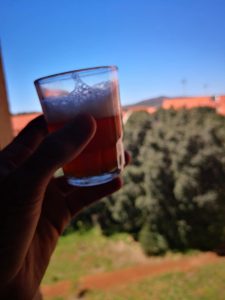Almost a month ago, I arrived in The Netherlands, I checked-in my student building in Voorschoten. All my neighbors are international students at Leiden University, and we are sharing one big kitchen on our floor. And as a Moroccan person, tea is a big part of my life. That is why I use the common kitchen to mainly prepare Moroccan tea.

It is very noticeable that sweet mint tea is a crucial part of Moroccan culture. It is a necessity in weddings, funerals… and the everyday life of most Moroccan people. The heavy presence of the famously known as “Berber Whiskey” in Moroccan culture makes it hard to believe that Moroccans only heard about tea in the 18th century (Bruke, 2009). A book written by Abd Kabir El Mjdoub El Fassi in the 19th century talked about the first uses of tea by Sultan Moulay Ismail to cure his son of alcoholism, and also about how tea was used as an effective method to gain the allegiance of “zaouiat”. Furthermore, tea was used by France and Great Britain to impose the protectorate in 1912 (Dlimi, 2017). Later on, tea became the favorite drink of Moroccans, and tea started being used in countless traditional songs, thus, melted into the diverse Moroccan culture.
So, my British neighbor, Thomas, comes into the kitchen and made a “British tea”. He boiled water and put a teabag in it. Once it transformed into ‘artificial tea’, he added milk, which caught my attention. We had a chat about how we are having the same drink, but they had different cultural and historical backgrounds and surely different tastes. Thomas said that tea is very common in the British lifestyle since it was introduced to Great Britain in the 17th century. Meanwhile, a second Indian neighbor, Saket, come in to make “Indian Chai”, which was very interesting since in the Arabic language we call tea ‘Chai’. Saket brought water milk and Chai spices. I asked him what Chai spices are made of, and he said that it is a mix of cinnamon, coriander, ginger, salt, and other ingredients.
This experience made me wonder how tea culture is heavily present in three randomly selected cultures, meanwhile, the origin of tea in China by full coincidence according to historians. That is why many questions popped into my mind afterward, such as does globalization theory apply within tea culture and industry?
And it got me reflecting on my identity as a Moroccan living in the Netherlands. If the ‘Berber whiskey’ is relatively new in the Moroccan culture while it has Chinese roots, and that the tea culture is so rooted in my culture that I even consume tea outside Morocco, then it makes me part of the Moroccan diaspora by definition. Are we looking at the ‘Glocalization’ of tea?
This anthropological evolution of Tea is very fascinating, and I believe that it requires more research from the theoretical perspective of the ‘discourses of globalization to understand the future of global tea culture chiefly in our globally connected competitive capitalist system. A famous Moroccan philosopher and futurist called Dr. Mahdi El Manjera wrote in his book “Clash of Civilizations” in 1973, he talks about a post-cold war influences. He argues that the new type of inter-states conflict is a cultural clash, which he grouped under mainly China using trade, the West (Europe and North America) using human rights and international organizations, and the Arab or Muslim World using ‘Petro-dollars’. The author even calls it the new face of colonialism. El Manjra’s claims match perfectly with my reflection on tea evolution because I realized that in a more globalized free trade world, tea multi-nationals will find themselves in front of the author’s expectation, which is ‘clash of cultures’. And I am honestly wondering if the Moroccan culture specifically, and the African culture generally, would survive in front of more hegemonic culture.
References:
- Burke III, “Edmund. Prelude to Protectorate in Morocco: pre-colonial protest and resistance, 1860-1912“. University of Chicago Press, 2009.
- Tamer Azzam DLIMI, “the French administration in Morocco 1939-1956”, 2017.


Mirjam de Bruijn
October 7, 2020 (19:51)
This is a very nice observation piece that then delves into the understanding what you have seen and how to interpret it. Indeed really nice to find the three tea cultures together in one kitchen.